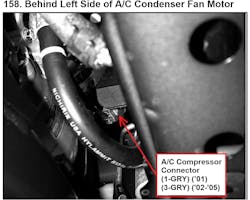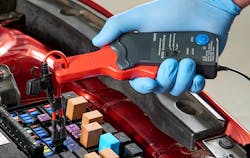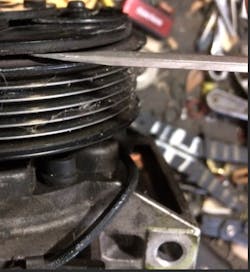Content brought to you by Motor Age. To subscribe, click here.
What You Will Learn:
• Building a mental image of a system at work is like having a bird's-eye view, which can help orchestrate a diagnostic approach
• Use easy to perform tests to determine what is working correctly so no time is wasted on unnecessary testing
• The lab scope and amp probe will demonstrate if the intended work is actually being performed correctly
I believe that one of the main challenges we technicians face is not so much finding the fault, but it is more so discovering a more efficient way of finding the fault. It's this decision to implement new techniques we are faced with that can sometimes be a challenge we are not ready to face. I mean, not many people enjoy the feeling of stepping outside of their comfort zone. I recognize that, but I want to show you how pushing yourself outside of that comfort-zone and implementing fresh tools and testing techniques can not only be satisfying but also financially rewarding as well.
The heat is on!
It was a typical summer day at the shop in Philadelphia, and by that I mean sweltering. It makes for a beautiful atmosphere to work in which typically everyone is smiling; however, the heat and humidity this time of year can tend to be a bit unbearable. That is about the time we received a phone call from a dear customer of ours named Joe. He had a complaint (like many others this time of year) of his vehicle's A/C system not performing well. Further inquiry on my behalf divulged that the A/C functioned wonderfully when it was working but wouldn’t work at all at times. This is not a typical complaint that customers share with me, but I told Joe to bring it down to the shop for evaluation.
Joe drives an immaculately maintained 2003 Honda Civic. It had an astonishing 290,000+ miles on the odometer, and the vehicle was still going strong (Figure 1). Joe was serious about keeping the vehicle on the road and having the A/C system functioning properly, so I agreed to advise him on what it would take to restore its functionality.
The background story to this case, according to Joe, was that the A/C blows ice cold at times. But at some point each day, it fails to deliver any comfort at all. A few hours later, the A/C functions just fine once again. This process seems to repeat itself each day throughout the week (at least during these dog days of summer).
Asking questions to create my diagnostic approach
Most of you know me by now and how I like to create a game plan. This allows me to take my time and use the facts derived from questioning the customer to aid in eliminating what simply cannot be. I'd like for you to imagine for a moment a list of 30 potential failures that could cause a specific symptom. Now imagine having to test every one of those components to prove their functionality. It's plain to see that this could be a large investment of time.
Now, what if we could ask some simple but important questions of the customer that will allow us to cut that list of 30 in half? What if we could then ask a subsequent question that could reduce that list of remaining potential failures by half again? How much more effective would our actual applied diagnostic time be?
It all starts with having enough knowledge about the functionality of a particular system (and the components that make up that system) to create a bird’s-eye view or mental image of that system (Figure 2). What I mean by that is being able to visualize all of the components of that system functioning together to accomplish the task it was designed to carry out. If we have that in-depth knowledge, we can certainly visualize what the symptoms may be if a component was not functioning properly. When we take the time to build that level of knowledge and understanding, we can truly become masters of what we do and very efficient at triaging a situation. All of this leads to effectively applied analyses and rapid, accurate diagnostics. For example, below are a few of the questions and answers shared between Joe and me:
Q: Does the A/C ever blow cold air?
A: Yes, it blows cold every morning, at my lunch break, and every evening leaving work.
Q: Does the blower ever quit pushing air at all?
A: No, during the symptom, air always comes from the vent — it's just very warm air.
Q: During the failure, do any indicators flash?
A: No, nothing unusual seems to occur — just the hot air blowing from the vents.
Q: Are there any notable noises/squealing heard during the failure?
A: No, the car seems to operate the same with no strange sounds.
Q: Is there a specific time/place the symptom is exhibited?
A: Yes, it always seems to fail after I stop for coffee in the morning.
I’m not sure if these questions seem relevant to you, but each one of them helps to narrow my diagnostic approach (eliminate possibilities) before I even sit in the vehicle. I’ll elaborate further.
The method to the madness
The first answered question tells me that the vehicle must have refrigerant in the system. It also tells me that the compressor clutch engages, the drive belt is affixed, and the heat can be exchanged from within the cabin and at the front of the engine compartment. The second answered question tells me that I don't have to invest any time in the blower circuit, as it always continues to push air, whether the symptom is present or not. The fact that no indicators are flashing leads me to believe the vehicle’s onboard computers don’t recognize a fault exists and the fact that there is no squealing noise deters me from thinking the compressor belt may be slipping. However, it’s Joe’s answer to the final question that caught my attention.
I asked Joe to elaborate a bit further with his last answer. He then stated that he has a 15-minute drive to a local gas station. Here, he stops each morning to get a cup of coffee. It's when he returns to his vehicle that the disappointment sets in and he is going to have a very uncomfortable commute to work. That is the time that the A/C system doesn’t function correctly. He goes on to say that when he leaves for his lunch hour, the A/C works flawlessly and again on his commute home from work.
There is a clue there that I'm hoping you are picking-up on. The first thought that comes to mind for me is "heat." Think about it...
With the initial morning start of the engine, it has 15 minutes of drive time to come to operating temperature. It's when Joe stops for coffee that the under-hood temperature begins to soar. We refer to this in the industry as "hot soak." Yes, the temperature under the hood initially climbs when the vehicle sits still/engine-off.
With that being said, I would like for you to reach back into your earlier years of automotive education and recall Ohm’s Law. Georg Ohm taught us all that there is a relationship between resistance, voltage, and current flow or amperage. We should remember that if resistance increases, it opposes current flow and therefore the current flow will reduce (Figure 3). Keep in mind that If the temperature of a component increases, so too does the resistance. So, it's only logical to recognize that as the temperature under the hood increases that electrical circuits will all have a reduction in current flow; it's just physics!
The analysis is applied science
As I initially approached the vehicle, I had a choice to make. I was either going to go on a 15-minute road test, return to the shop and allow the vehicle to hot soak (just as Joe experienced the symptom) before I attempt testing. This would likely be a wise decision, as I was almost sure to experience the symptom. e all know that to reproduce the customer's concern is almost ALWAYS the first step in the troubleshooting process. The other choice would have been to pull the vehicle into the shop and analyze some data from the A/C system as it appeared to function normally. I decided to go with the latter, as I was curious to compare the differences between the system functioning normally and when faulted.
We all know there is more than one way to come to a diagnosis on a vehicle. Although my approach changes depending on factors like vehicle configuration, available tooling, and circuit access, my goal is always the same: The most efficient approach to the fault. At the moment, the A/C system is engaged and performing well. There is not a fault present in the related circuitry of the A/C compressor clutch field coil, but I still chose to evaluate its performance. To do this meant for me to utilize a current probe and a lab scope. The lab scope offers me the power of a DVOM (digital volt/ohmmeter), but it offers a bit more. For instance, it allows me to see the change in the circuit operation over some time, whereas a DVOM only allows me to see circuit activity at a moment in time. The lab scope also offers a visual representation of electricity. This means I'm allowed to see the circuit perform the work it was designed to do but will also allow me to see when a failure occurs and the nature of the failure.
The current probe is a device many of you either implement or have at least heard of before. The current probe (or amp probe) is quite handy, as it can deliver information by simply clamping around the outside of a wire in a circuit. As the electrical current travels through the wire, a magnetic field is created. This magnetic field grows stronger with an increase in current flow. When coupled to a lab scope, the current probe trace can show us not only electrical current flow, but also the physical movement of inductive devices like solenoids. As a ferrous metal is moved through a magnetic field (like within a solenoid), a disruption in current flow occurs. If we see that disruption, it’s indicative that the solenoid shuttled. Yes, we can see physical movement with a current probe. It’s this knowledge I will lean on as I capture and analyze the current trace from the A/C compressor. After all, it is nothing more than a large solenoid.
I want to back up for a moment and state the reason I chose to monitor current flow to evaluate the A/C compressor clutch circuit. Current is the same anywhere in a series circuit. With that being stated, it's quite a task to place the vehicle in the air and test the A/C compressor clutch circuit for available voltage, voltage drop, or even continuity (Figure 4). The amp probe will offer similar information. For instance, if the current flow is at what's expected, there simply cannot be any open circuits, excessive resistance, or voltage drop anywhere within the circuit — Ohm’s Law taught us that! Furthermore, if the current flow was less than expected, it would now be justified to investigate the circuit a little deeper. We would be sure to find our fault as we pursued further using a DVOM but without any wasted time.
The determining factor
Reminding you that current is the same anywhere in a series circuit, I chose to monitor current at the under-hood fuse box because it was so easily accessible (Figure 5). By requesting the compressor clutch "on," I captured the current ramp of the A/C compressor clutch field coil. At about three amps, it revealed that the circuit was indeed healthy, but something much more interesting was revealed as well. A "pintle bump" is the visual indicator that demonstrates physical movement or shuttling of the compressor clutch. The circuit is engineered so that the bump will occur approximately 50-60 percent of the way up the current ramp. Although this A/C compressor clutch is operating properly at this time, it can be seen that the bump is occurring very late (Figure 6). If there was a reduction in current flow, there would certainly be a reduction in a magnetic field, and one may anticipate a late pintle bump (shuttling of the clutch) as a result. However, there is no reduction in current flow. So, a question comes to mind: What factor other than magnetic field can affect the engagement of the compressor clutch? You guessed it, — the air gap!
Although the A/C compressor clutch has not failed to engage as of yet, the data in the current ramp directed my attention to the air gap of the compressor clutch. According to specification, the gap should be no more than .026". The measured air gap across the A/C compressor clutch was almost double that distance! (Figure 7).
Connecting the dots
I decided to prove my case and point before approaching the customer. I took the vehicle on the road to generate some heat energy. I allowed the vehicle to sit for 10 minutes and repeated my test. What I found (although not displayed here) confirmed my hypothesis. The added heat from the road test/hot soak indeed reduced current flow due to the increase in resistance. Of course, this reduced the amount of magnetism generated by the energized clutch field coil. As a result, the excessive air gap didn’t allow the clutch to engage. There was not enough magnetism to overcome the large air gap. A minor bump/coaxing with the end of my prybar allowed the magnetic field to draw the compressor clutch closed, and the A/C system functioned and performed well. Again, there was nothing wrong with the magnetic field, just too large a gap to overcome.
Growing your skillset is never promised to be easy and can more often than not force us outside of our comfort zone. That's how you know you are striving to better yourself. No one is going to force you to be more efficient, especially if you are already diagnosing and repairing vehicles correctly. But I can promise you three things if you do: a strong sense of pride, reduced stress at work, and a much better understanding of how components function as a system to accomplish a task.
About the Author
Brandon Steckler
Technical Editor | Motor Age
Brandon began his career in Northampton County Community College in Bethlehem, Pennsylvania, where he was a student of GM’s Automotive Service Educational program. In 2001, he graduated top of his class and earned the GM Leadership award for his efforts. He later began working as a technician at a Saturn dealership in Reading, Pennsylvania, where he quickly attained Master Technician status. He later transitioned to working with Hondas, where he aggressively worked to attain another Master Technician status.
Always having a passion for a full understanding of system/component functionality, he rapidly earned a reputation for deciphering strange failures at an efficient pace and became known as an information specialist among the staff and peers at the dealership. In search of new challenges, he transitioned away from the dealership and to the independent world, where he specialized in diagnostics and driveability.
Today, he is an instructor with both Carquest Technical Institute and Worldpac Training Institute. Along with beta testing for Automotive Test Solutions, he develops curriculum/submits case studies for educational purposes. Through Steckler Automotive Technical Services, LLC., Brandon also provides telephone and live technical support, as well as private training, for technicians all across the world.
Brandon holds ASE certifications A1-A9 as well as C1 (Service Consultant). He is certified as an Advanced Level Specialist in L1 (Advanced Engine Performance), L2 (Advanced Diesel Engine Performance), L3 (Hybrid/EV Specialist), L4 (ADAS) and xEV-Level 2 (Technician electrical safety).
He contributes weekly to Facebook automotive chat groups, has authored several books and classes, and truly enjoys traveling across the globe to help other technicians attain a level of understanding that will serve them well throughout their careers.







